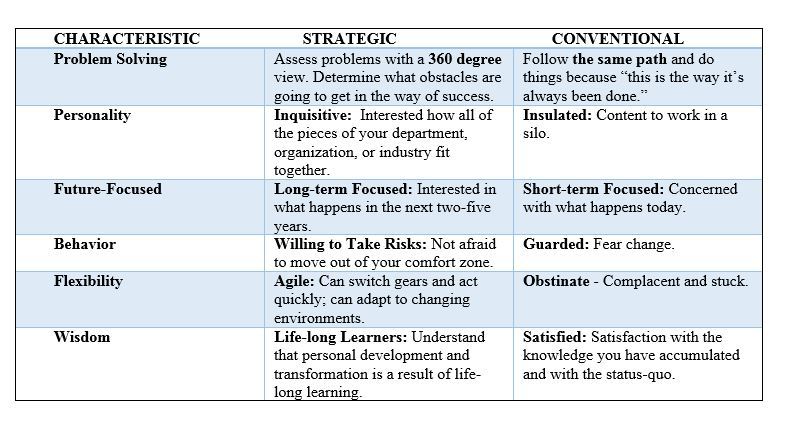“I want to be more strategic.” That’s one of the most common sentiments that I hear from my clients. But, what’s that really mean? There’s no class you can take that certifies you as “strategic.” Strategic thinking goes beyond thinking about what is—it includes envisioning what could be.
It’s a thought process that provides a renewed approach to your industry and to your organization. It’s having a unique stance on emerging trends or technologies with the aptitude to blend those trends into your current environment.
It’s also having the mental capability to reframe old issues with new solutions.
How Does Strategic Thinking Differ From Conventional Thinking?
Strategic thinkers take a wide-ranging, long-term approach to problem-solving that involves neutral analysis, planning, and competent decision-making.
What’s strategic thinking look like?
How can you become more strategic?
1. Be Future-oriented:
Lead the way instead of lag behind. The term ‘visionary’ may seem like a strong word but you must focus on what is down the road. Knowing what makes you a game-changer in your industry keeps you focused on the future.
You must:
- Understand how your industry is changing. Know what new technologies impose a threat to your products or services and understand how you can use those new technologies to your advantage.
- Understand what emerging threats will leave you vulnerable.
- Understand what your competitors do or have that can take your business away.
- Understand how society and your workforce are changing.
How:
Research the market, industry, customers, clients, competitors and new technologies that influence your business. Broaden your knowledge and foundation of expertise.
2. Question Everything, Challenge Assumptions, and Make Critical Decisions:
“This is the way that it has always been done” doesn’t fly for the strategic thinker. The strategic thinker is open to embracing new ideas but doesn’t lose common judgment and they don’t take things for face value. They will dig away at issues until they determine the root cause – and then they will fix it.
How:
You sift through the BS.
You’ll need to gather sufficient information to make sense of an issue before you can decide on a course of action. You have to consider what you already know and what other pieces are still missing.
The strategic thinker asks “what” and “why.” Conventional thinkers ask “how” and “when.”
You develop an ability to sift through analysis, recognize patterns, and construct mental models. In “regular” thinking, a person is more likely to accept facts without investigating and analyzing the issue.
Strategic thinking is the opposite. A strategic thinker doesn’t believe they hold all of the answers. They will listen to numerous viewpoints and question prevailing assumptions before they make decisions.
Don’t be afraid to ask tough questions. Asking questions is perhaps the classic act of critical and strategic thinking. Finding the answer, and finding it methodically, is what critical thinking is all about. Know what piece of the puzzle is missing. Consistently ask “what” and “why”. Learn to trust your instinct.
3. Gain Consensus Through Dialogue:
A strategic thinker will foster open dialogue, build trust, and engage key stakeholders, especially when views diverge.
To pull that off, you need to:
- Understand what drives other people’s agendas, including what remains hidden.
- Bring tough issues to the surface, even when it’s uncomfortable.
How:
Keep people informed on what is happening in the organization. Share information and communicate a well-articulated philosophy. Your employees need to understand the broader organizational strategy in order to incorporate it into their own plans and strategies. Once they understand the big picture, their input will be instrumental to the organization.
To receive similar content, “Like” us on Facebook @ https://www.facebook.com/niagarabuzz.ca














